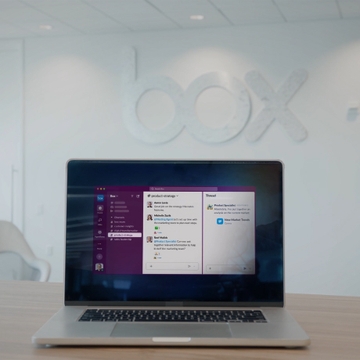TOYOTA CONIQ Pro, Inc., a successor company of Delphys Inc., was established in January 2021 with investment from Toyota Motor Corporation and Dentsu Group. The company manages marketing services, consultancy and mobility services for Toyota Motor Corporation and companies in the Toyota Group.
When the company began operations, COVID-19 made it difficult for workers to collaborate in-person, so remote communication was essential for everyone, even for new members, in order to ensure that the business could be set up as smoothly as possible. However, at that time, communication was reliant on email, and so there were some challenges in terms of efficiency.
To combat this, the company introduced Slack as a new communication platform to meet its goals of improving operational efficiency and fostering a sense of unity within the company. We spoke to Eiji Honma and Hiroshi Mitsutake, managers of the General Affairs Unit, Corporate Design Dept., Corporate Design HQ for the company, about how they integrated Slack into their company.
The challenges of setting up a new company remotely. Scalability outside the company is key
Since the new company was established during the COVID-19 pandemic, the Corporate Design Dept., which is responsible the company’s IT, started to consider how employees could actively communicate with each other in a remote environment, including with new employees coming from Toyota Motor Corporation and Dentsu Group.
The company already had a cloud-based communication app that had been introduced during the Delphys era. But employee usage was low, and daily exchanges were centered around email. While starting the new company, we needed a new communication tool to replace email so that our new team could get on with their projects smoothly.
“To start working in a remote environment, including with new team members, we needed a new tool that would allow us to quickly and openly share information, rather than doing so through more time-consuming methods like email” Mitsutake says, looking back. Additionally, since becoming a new company, the team began to cooperate more closely with other Toyota Group companies, so active communication with external companies also became essential. As a result, the ability to extend communications outside our company became a decisive factor, and so we decided to implement Slack.
In order to start working in a remote environment, including with new team members, we needed a new tool that would allow us to quickly and openly share information, rather than doing so through more time-consuming methods like email
3 months to completely eliminate pain points with a trial implementation
Under these circumstances, it was decided that Slack would be implemented company-wide as a new communication tool from January 2021, in line with the establishment of the new company. A project team was formed, led by two people, Mr. Honma and Mr. Mitsutake, for the company-wide implementation. We carried out a 3-month trial for around 200 people. The company itself has around 600 employees, so the scale was around one third of the whole company, but “I decided to risk implementing on such a large scale in order to get more feedback and eliminate as many problems as possible once fully operational,” said Mitsutake, discussing his goals.
During this trial period, the Corporate Design Dept. focused on ensuring security and establishing stable operations. To prevent inadvertent information leaks and access by malicious third parties, we have taken security measures such as limiting Slack’s use to company machines and enforcing a single sign-on by having users connect to Azure AD, the company’s ID management platform.
“Preventing the leaking of company information should be a key priority for any modern IT department. As the department responsible for IT, we cannot overlook any concerns regarding security management,” says Mr. Honma.
Also, during the trial, employees were manually carrying out user registration, and I felt there were issues with the workload and the possibility for error. For example, if someone were to forget to deactivate the account of an employee who had left the company, there would be a risk of that employee continuing to access company information. In response to these operational issues, Mitsutake comments that “during the trial, a Slack representative came up with the idea of linking employee Slack accounts to Azure AD so they will both be disabled when an employee leaves the company. As this also eliminated the need for registration work when taking on new employees, this secure operating system was established with much less strain on operating times, both physically and mentally. Being able to get this kind of advice and support from Slack was very encouraging.” Following verification of the trial implementation, Slack finally went live in May 2021.
Accelerating group collaboration for content production with Slack Connect
At the same time as Slack going live, TOYOTA CONIQ Pro started using Slack Connect for external information sharing. Before starting to use Slack Connect, we set some guidelines for external information sharing, and came up with ways to raise awareness of secure information sharing procedures among employees. As a result, the company can improve the speed of information sharing, not only internally, but also externally, while simultaneously eliminating security risks. “Slack Connect puts our minds at ease as we are able to set permissions for the information that each external business partner can access when they connect,” says Mitsutake. Currently, within the company, the biggest advantage of Slack Connect is the information sharing between groups when creating content. When planning and editing content for a company such as Toyota, which is both a client and a group company, cooperation within the group is essential. In the past, telephone and email were used for internal and external communication, so it would often take some time to make adjustments. However, by using Slack Connect, it is now possible to share information in a timely manner, not just internally but also with all external stakeholders. Mitsutake continues to elaborate on this kind of information sharing between groups using Slack Connect. “I feel that the synergy of the entire group is being enhanced by Slack Connect as it allows information to be shared in real time. Going forward, we would like to increase the number of business partners using Slack Connect.”
By opening up our information channels, we enable faster handovers and create a sense of unity
Mitsutake highlights another key difference between email and Slack, which is the openness of information. “With email, the information only reaches the recipient, and multiple topics may be discussed in a single email, whereas Slack organizes channels according to their theme, so it’s easy to include background information, and you can quickly access the information you need. Until recently, whenever a new member joined a project, it would require hours of handover meetings to get them up to speed. But with Slack, all you say is ‘please look through the information in this channel’, and then you’re practically done. I think this difference is quite significant,” explains Mitsutake. The openness of the information also has the effect of breaking down walls within the internal organization. As an example, Mr. Honma showed us a channel that allows for direct communication between the company president and the employees. In that channel, employees and management teams, including other directors, are directly and freely interacting with each other through Q&As. “I feel that the relationships between the management teams and the employees have become much closer, as well as the relationships between the employees themselves. The psychological hurdles for employees to communicate with the management teams have all been lowered, creating a sense of unity within the company. I think this was possible because Slack, unlike other business tools, is easy to use and has a sense of fun about it,” said Honma, referring to the changes that Slack has brought about.
A driving force for the future with potential improvements in operational efficiency
Previously, while introducing a different tool, the company had strongly recommended it and pushed for its use. However, our experience was that this meant it didn’t really catch on. So this time around, in the Corporate Design Dept., we didn’t try to force a transition to Slack from our existing tools. As a result, about half a year after introducing Slack, about 70% of our employees use it four times a week, and Slack is already starting to establish itself as the standard communication tool within the company. Commenting on this, Mr. Honma said, “Even though we made migrating over to Slack completely optional in the end, the use of Slack has grown exponentially. I truly believe that people naturally migrate toward tools that are easy to use.” Finally, when asked about prospects for the future, Mr. Mitsutake enthusiastically remarks, “Looking back at the origin of business efficiency, I want to look at cooperation with other business applications, using Slack as a hub, such as for file co-editing, attendance management, workflows, and so on.” By implementing Slack, TOYOTA CONIQ Pro has not only achieved a sense of unity among employees in the new company, but also secure, real-time information coordination between its group companies. It is expected that further potential improvements will also be made in new projects in the future.
Even though we made migrating over to Slack completely optional in the end, the use of Slack has grown exponentially. I truly believe that people naturally migrate towards tools that are easy to use.















